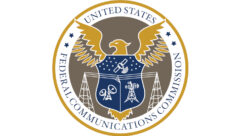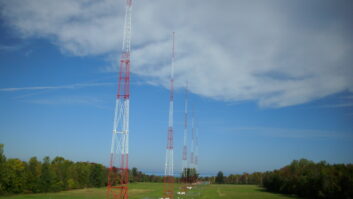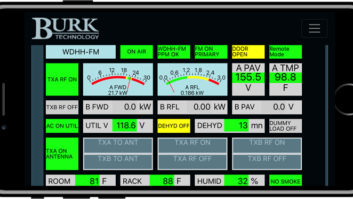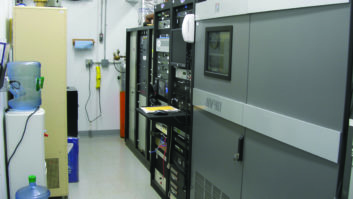Care of transmission lines
Dec 1, 2000 12:00 PM, John Battison
Most radio engineers will agree that after the antenna and ground system, transmission lines are probably the most neglected item. For both AM and FM, the towers and their associated components don’t appear to do much. Consequently, much of the transmission system receives no attention.
While most of the transmission line installed outdoors is flexible line, rigid line is common for inside installations. Because rigid line rarely has a jacket, damage can be easily seen.
Most AM stations have several hundred feet of coaxial cable either buried underground or suspended aboveground on a support system. Buried lines make a cleaner-looking antenna site and incur a reduced risk of vandalism. Current practice leans toward buried cables. Maintenance on above-ground cables must include a very careful mechanical inspection for signs of attempted cuts or bullet holes.
Regardless of the distance between the transmitter building and the tower, the condition of any coax run to the ATU needs to be inspected. Sometimes it’s under the floor in a trough. Sometimes it runs over the top of the transmitter cabinets.
Under-floor cable has been known to suffer from rodent chewing and occasional flooding or even foundation movement. Over-the-top cables often rest on hot cabinet tops, and even the best materials sometimes suffer heat exhaustion. Chewing, heat and/or mechanical strain can produce a breakdown of insulation with resulting fireworks. There should not be any sharp bends, but if there are any, be sure to check them for heating.
Ice protection is important for any coaxial cables within the ice fall zone of the tower. This applies to flexible and rigid lines. An ice bridge is cheap protection against falling ice and any other debris from the sky.
It’s very important to inspect cable runs regularly when performing the tower/light inspection or maintenance and to note their condition in the log.
Immediately after WWII, RG-17 was popular in AM because there was plenty of it. This solid-dielectric cable may still be found in some of the older and smaller AM stations. It was a good cable, and many hams have used it very successfully. However, it has fairly high loss, and I don’t know of many stations still using it.
If you are one of the few still using RG-17, the best check is probably mechanical, looking for damage to the sheathing and possible corrosion in exposed areas. If a TDR is available, and down time is permitted, it’s a good idea to check it out for any impedance discontinuities caused by ill treatment over the years.
Long-term care In the absence of uncontrolled excavations or back-hoe work, buried cable should be reasonably safe for a number of years. Nevertheless, I like to disconnect each end of the line and measure its impedance with the far end shorted. If this is done routinely, and good records are kept, signs of deterioration can often be found sooner.
At the same time, end couplings should be checked for corrosion. Sometimes copper strap has been brazed to the outer conductor at the antenna end. If excessive heat has been used, there is risk of dielectric failure at the brazing point.
Sometimes a strange abrasion is found where cable passes over a concrete or similar opening; any vibration can wear a hole right through the outer casing. There have been cases where vibration was due to an air conditioner or ventilation fan. These effects work slowly, but they can catch up with a system.
For stations using dry air or nitrogen in pressurized lines, good engineering practice involves maintaining a log of gas use or compressor behavior. Regular logging of gas usage can often help catch an incipient line leak. If leaks are suspected, tower work will not always lend itself to finding the leak. Again, a TDR can often pinpoint the problem.
In my opinion, FM station coaxial cables are more susceptible to cable damage. I’ve seen a number of FM installations where the drum of cable was delivered and mounted, and installation commenced without proper precautions and raising materials. If a proper cable hoist grip is not used, the cable ends can be damaged. Wild, fast hauling of cable can break it, stretch it or change its diameter enough to produce impedance discontinuities. At the same time, correct, properly-spaced cable supports must be used to prevent stretching of suspended sections.
It is becoming more difficult to make antenna and transmission line measurements at multitower antenna or transmitter installations. However, if they can be scheduled, TDR checks are extremely worthwhile. Developing antenna problems will often be discovered, and poor connections and other discontinuities will be found.
Special attention Coax that has been spliced should always be suspect if there appears to be a cable problem. Although splicing kits do an excellent job once the cable has been cut and a new piece spliced, there is always the risk of an air leak or a less-than-perfect metallic splice that can heat up and burn.
If a transmission line to an AM DA has to be spliced, it is essential to be sure the total length is not changed by adding the new piece of cable. A change of only a few feet can produce an antenna monitor reading that is outside acceptable limits.
In the field of DAs, another kind of transmission line should not be forgotten: the antenna sample line. A critical array, or even a regular type approved system using specially tempered sample line, must be inspected regularly. Should a line be damaged, the same type of line must be used for the replacement.
Buried sampling lines require the same care as transmission lines. Unfortunately, damage often occurs to lines and ground systems when trucks are driven through the area. Splicing a new piece of line or repairing a broken line is not a good idea. It can be done, and often seems to work quite well, but splices have a habit of causing trouble after a while.
It is common for all sampling lines to be of the same length and material for ease of adjustment. The FCC even requires it in some installations. This means that a length of standard coax can’t replace a piece of special monitor cable. Remember that all of the antenna monitor cables must experience the same environment. If some cables are too long, they have to be buried in the same manner as the remainder and should not be left lying on the ground. Transmission line maintenance pays off in routine operations, but especially on a cold snowy night in winter.












